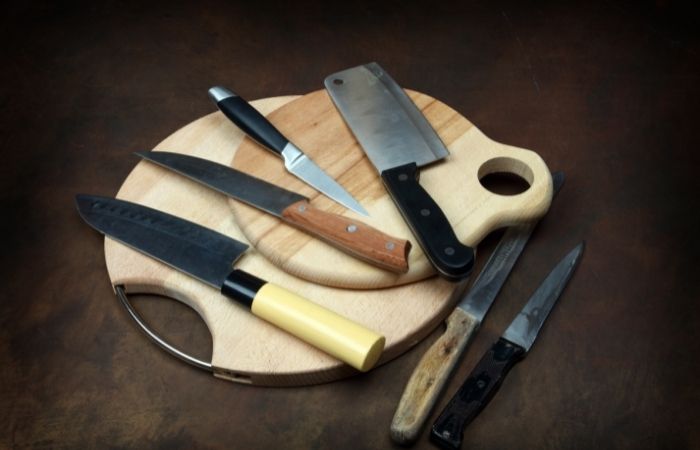
With so many knives to choose from, it can be hard to rule down purchases only to three. Still, knowing which ones are the most essential can make the life of any kitchen novice or trained chef easier?all the way from slicing beef cubes to dicing an entire watermelon.
On top of varieties, the knife’s price also matters. There are high-end and budget picks to consider.
Simply put, regardless of brand and size, having the right tool and knowing the most important types can help maximize your time in the kitchen. It will also help you create almost every dish there is with better control, consistent cuts, and less slippage.
The Three Most Important Knives
Anyone who works in a kitchen really only needs three types of knives: a serrated knife, a paring knife, and a chef’s knife. Equally important to know is how to use and how not to use each type, especially to avoid injury or disasters in the kitchen.
Detailed below is a quick guide about these knives for you to understand each of them better.
Serrated or Bread Knife
Serrated knives, also known as bread knives due to the common association with slicing bread, have a series of teeth on the blade edge. They can handle other jobs in the kitchen that other knives are not fit for, such as a chef’s knife that only has a straight blade.
With their sharp points designed for various types of cutting, it is great for sawing action or backward and forward slicing. Its average length of six inches is also ideal for its many functions.Some functions best associated with serrated knives include handling food with waxy surfaces, such as fruits.
With the serrated knife’s jagged edges, it can penetrate slippery exteriors. It is not possible with knives that have flat blades. Though, despite its flexibility, you should not use it for chopping. That said, it is perfect for slicing smaller items like berries, herbs, and garlic.
Paring Knife
The second must-have knife is the paring knife, which is perfect for smaller, intricate kitchen work. It has a compact design for better dexterity and maneuvering when you prepare food. With paring knives, you’ll enjoy versatility and precision.
Tasks that require attention to detail, such as removing seeds from peppers and deveining shrimp, are best done with a paring knife. Getting into tight corners is also made possible, considering its average blade length of three to four inches.
However, you must not use paring knives when working on tough vegetables, such as parsnips and carrots. Since these knives are smaller, they lack the weight needed to slice through such surfaces. It might even cause more pressure or a tightened grip, which is not ideal when doing kitchen work and might even lead to injury and knife slippage.
On another note, there are different types of paring knives, such as the curved tip, bird’s beak, and sheepsfoot. It is unnecessary to have all different types, but it might come in handy to know which one best suits which task.
For example, sheepsfoot-style paring knives work well for cutting both hard and soft kinds of cheese into thin slices.
Chef’s Knife
Lastly, the most important knife to add to your kitchen is a classic chef’s knife. Averaging eight to 10 inches in length, this knife is an efficient and versatile ally in the kitchen. In fact, 90% of kitchen work will rely on a chef’s knife. One uses it to slice and dice fish, meat, vegetable, and fruit.
The sharpness of chef knives also gives one more control of blade movement for food. One also tends to be more careful because the sharp nature of the chef’s knife makes it predictable to prevent injury.
In spite of it being hailed as the “king of the kitchen”, carving and butchering poultry and removing the skin of bigger vegetables like butternut squash should not be done with a chef’s knife. Its broadness does not bode well for these types of tasks, for which you will need your smaller knives.
The Bottom Line
Given the three most important types of knives, it is still just as important to consider other factors. “Steel and feel” is one indicator of whether you have the knives you need.
It has to be comfortable and support you while you’re cooking. Finding one with an ergonomically design grip is also recommended. You also want steels that can hold a sharp edge better. With carbon steel (designed to work with any moisture) and softer stainless steel, the sky’s the limit with choices for kitchen equipment.
On another note, storage, sharpening, and cleaning will go a long way when it comes to handling your knives. As they say, take care of your templar knife, and it will serve you well and long.
Happy cooking!
References –
https://www.huffpost.com/entry/the-4-knives-every-home-c_b_4385949
https://www.huffpost.com/entry/misen-chefs-knife_b_8339076
https://www.kuhnrikon.co.uk/recipes-blog/post/advantages-of-serrated-knives/
https://www.jlhufford.com/blogs/newest-posts/the-benefits-of-a-paring-knife
https://www.huffpost.com/entry/best-affordable-chefs-knife_l_5d80fb59e4b03b5fc88a5364
https://viebelles.co/blogs/care/benefits-of-a-good-chef-knife
https://www.lacademie.com/what-is-a-paring-knife-used-for/
Hey welcome to my blog . I am a modern women who love to share any tips on lifestyle, health, travel. Hope you join me in this journey!

Speak Your Mind